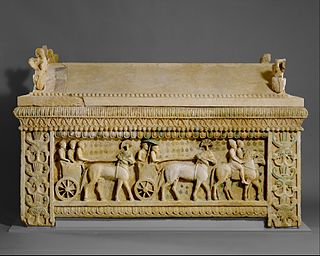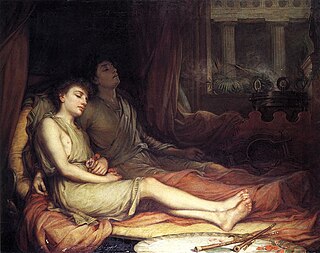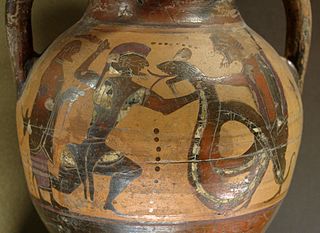Related Research Articles
Aphrodite is an ancient Greek goddess associated with love, beauty, pleasure, passion and procreation. She was syncretized with the Roman goddess Venus. Aphrodite's major symbols include myrtles, roses, doves, sparrows, and swans. The cult of Aphrodite was largely derived from that of the Phoenician goddess Astarte, a cognate of the East Semitic goddess Ishtar, whose cult was based on the Sumerian cult of Inanna. Aphrodite's main cult centers were Cythera, Cyprus, Corinth, and Athens. Her main festival was the Aphrodisia, which was celebrated annually in midsummer. In Laconia, Aphrodite was worshipped as a warrior goddess. She was also the patron goddess of prostitutes, an association which led early scholars to propose the concept of "sacred prostitution" in Greco-Roman culture, an idea which is now generally seen as erroneous.

Amathus or Amathous was an ancient city and one of the ancient royal cities of Cyprus until about 300 BC. Some of its impressive remains can be seen today on the southern coast in front of Agios Tychonas, about 24 miles (39 km) west of Larnaca and 6 miles (9.7 km) east of Limassol. Its ancient cult sanctuary of Aphrodite was the second most important in Cyprus, her homeland, after Paphos.

In Greek mythology, Aegeus was an archaic figure in the founding myth of Athens. The "goat-man" who gave his name to the Aegean Sea was, next to Poseidon, the father of Theseus, the founder of Athenian institutions and one of the kings of Athens.

In Greek mythology, Hypnos is the personification of sleep; the Roman equivalent is known as Somnus. His name is the origin of the word hypnosis.

In Greek mythology, the Minotaur is a mythical creature portrayed in Classical times with the head and tail of a bull and the body of a man or, as described by Roman poet Ovid, a being "part man and part bull". He dwelt at the center of the Labyrinth, which was an elaborate maze-like construction designed by the architect Daedalus and his son Icarus, on the command of King Minos of Crete. The Minotaur was eventually killed by the Athenian hero Theseus.

Theseus was the mythical king and founder-hero of Athens. Like Perseus, Cadmus, or Heracles, Theseus battled and overcame foes that were identified with an archaic religious and social order. His role in history has been called "a major cultural transition, like the making of the new Olympia by Hercules."

Ariadne was a Cretan princess in Greek mythology. She was mostly associated with mazes and labyrinths because of her involvement in the myths of the Minotaur and Theseus. The ancient Roman author Hyginus identified Ariadne as the Roman Libera/Proserpina at approximately the same time as Libera was officially identified with Proserpina in 205 BC, these two names becoming synonymous for the same goddess. Hyginus equated Libera/Proserpina with Ariadne as bride to Liber whose Greek equivalent was Dionysus, the husband of Ariadne.

In Greek mythology, Peitho is the goddess who personifies persuasion and seduction. Her Roman equivalent is Suada or Suadela. She is typically presented as an important companion of Aphrodite. Her opposite is Bia, the personification of force. As a personification, she was sometimes imagined as a goddess and sometimes an abstract force with her name used both as a common and proper noun. There is evidence that Peitho was referred to as a goddess before she was referred to as an abstract concept, which is rare for a personification. Peitho represents both sexual and political persuasion.

Aphrodite Pandemos occurs as an epithet of the Greek goddess Aphrodite. This epithet can be interpreted in different ways. Plato and Pausanias describe Aphrodite Pandemos as the goddess of sensual pleasures, in opposition to Aphrodite Urania, or "the heavenly Aphrodite". At Elis, she was represented as riding on a ram by Scopas. Another interpretation is that of Aphrodite uniting all the inhabitants of a country into one social or political body. In this respect she was worshipped at Athens along with Peitho (persuasion), and her worship was said to have been instituted by Theseus at the time when he united the scattered townships into one great body of citizens. According to some authorities, it was Solon who erected the sanctuary of Aphrodite Pandemos, either because her image stood in the agora, or because the hetairai had to pay the costs of its erection. The worship of Aphrodite Pandemos also occurs at Megalopolis in Arcadia, and at Thebes. A festival in honour of her is mentioned by Athenaeus. The sacrifices offered to her consisted of white goats. Pandemos occurs also as a surname of Eros. According to Harpocration, who quotes Apollodorus, Aphrodite Pandemos has very old origins, "the title Pandemos was given to the goddess established in the neighborhood of the Old Agora because all the Demos (people) gathered there of old in their assemblies which they called agorai." To honour Aphrodite's and Peitho's role in the unification of Attica, the Aphrodisia festival was organized annually on the fourth of the month of Hekatombaion. The Synoikia that honoured Athena, the protectress of Theseus and main patron of Athens, also took place in the month of Hekatombaion.

Paphos is a coastal city in southwest Cyprus and is the capital of Paphos District. In classical antiquity, two locations were called Paphos: Old Paphos, today known as Kouklia, and New Paphos.

Astarte is the Hellenized form of the Ancient Near Eastern goddess Astoreth, a form of Ishtar, worshipped from the Bronze Age through classical antiquity. The name is particularly associated with her worship in the ancient Levant among the Canaanites and Phoenicians. She was also celebrated in Egypt following the importation of Levantine cults there. The name Astarte is sometimes also applied to her cults in Mesopotamian cultures like Assyria and Babylonia.
Eucleia or Eukleia was the ancient Greek female personification of glory and good repute. Along with her sisters, Eupheme, Philophrosyne and Euthenia, she was likely regarded as a member of the younger Charites. According to Plutarch, Eucleia may have also been used as an epithet of Artemis.

Minotaur, the Wild Beast of Crete is a 1960 film based on the Greek legend of Theseus, the Athenian hero who is said to have slain a minotaur on Minoan Crete around 1500 or 1450 BC. The film was directed by Silvio Amadio and starred Bob Mathias.

Aphroditus or Aphroditos was a male Aphrodite originating from Amathus on the island of Cyprus and celebrated in Athens.
In Greek mythology, the people of Athens were at one point compelled by King Minos of Crete to choose 14 young noble citizens to be offered as sacrificial victims to the half-human, half-taurine monster Minotaur to be killed in retribution for the death of Minos' son Androgeos.

Roman Cyprus was a small senatorial province within the Roman Empire. While it was a small province, it possessed several well known religious sanctuaries and figured prominently in Eastern Mediterranean trade, particularly the production and trade of Cypriot copper. The island of Cyprus was situated at a strategically important position along Eastern Mediterranean trade routes, and had been controlled by various imperial powers throughout the first millennium BC. including: the Assyrians, Egyptians, Macedonians, and eventually the Romans. Cyprus was annexed by the Romans in 58 BC, but turbulence and civil war in Roman politics did not establish firm rule in Cyprus until 31 BC when Roman political struggles ended by Battle of Actium, and after about a decade, Cyprus was assigned a status of senatorial province in 22 BC. From then on to the 7th century Cyprus was controlled by the Romans. Cyprus officially became part of the Eastern Roman Empire in 293 AD.

Aphrodite of the Gardens is an epithet of the Greek goddess Aphrodite. The epithet describes her patronage over vegetation and garden fertility.
The Aphrodisia festival was an annual festival held in Ancient Greece in honor of the goddess of love and beauty, Aphrodite. It took place in several Ancient Greek towns, but was especially important in Attica and on the island of Cyprus, where Aphrodite was celebrated with a magnificent celebration. The festival occurred during the month of Hekatombaion, which modern scholars recognize as starting from the third week in July to the third week of August on the Gregorian calendar. Aphrodite was worshipped in most towns of Cyprus, as well as in Cythera, Sparta, Thebes, Delos, and Elis, and her most ancient temple was at Paphos. Textual sources explicitly mention Aphrodisia festivals in Corinth and in Athens, where the many prostitutes that resided in the city celebrated the festival as a means of worshipping their patron goddess. Though no textual sources expressly mention an Aphrodisia festival in Cythera, Thebes, or Elis, it likely occurred since textual and iconographical sources indicate that Aphrodite Pandemos had a cult following in these areas. The Aphrodisia festival was one of the most important ceremonies in Delos, though we do not know much about the details of the celebration. The inscriptions merely indicate that the festival required the purchase of ropes, torches and wood, which were customary expenses of all Delian festivals.
In Greek mythology, Androgeos or Androgeus was a Cretan prince.
Helenos was a Ptolemaic governor of Cyprus in the second century BC. He came from Cyrene and was the son of either a man called Apollonius or of Apollodorus the epistrategos of Thebais.
References
- Ellis, Robinson, A Commentary on Catullus, Kessinger Publishing, LLC, 2007. ISBN 978-1-4304-8658-9.
- Mitford, Terence Bruce, "The Cults of Roman Cyprus" in Aufstieg und Niedergang der römischen Welt: Geschichte und Kultur Roms im Spiegel der neueren Forschung, Volume 1, Walter de Gruyter, 1972. ISBN 978-3-11-001885-1.
- Parpola, Simo, Robert M. Whiting, Sex and gender in the Ancient Near East: Proceedings of the 47th Rencontre Assyriologique Internationale, Helsinki, July 2–6, 2001, Part 1, Neo-Assyrian Text Corpus Project, 2002. ISBN 978-951-45-9054-2.
- Plutarch. Plutarch's Lives. with an English Translation by. Bernadotte Perrin. Cambridge, MA. Harvard University Press. London. William Heinemann Ltd. 1914
- Harris, J. Rendel, The Origin of the Cult of Aphrodite, in Bulletin of the John Rylands Library, Volume 3, John Rylands Library, Henry Guppy, Manchester University Press, 1917.
- Hill, Sir George Francis, A History of Cyprus, Volume 1, University Press, 1952